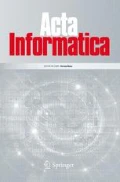Abstract
In this paper, we consider the class of Boolean μ-functions, which are the Boolean functions definable by μ-expressions (Boolean expressions in which no variable occurs more than once). We present an algorithm which transforms a Boolean formulaE into an equivalent μ-expression-if possible-in time linear in ‖E‖ times\(2^{n_m } \), where ‖E‖ is the size ofE andn m is the number of variables that occur more than once inE. As an application, we obtain a polynomial time algorithm for Mundici's problem of recognizing μ-functions fromk-formulas [17]. Furthermore, we show that recognizing Boolean μ-functions is co-NP-complete for functions essentially dependent on all variables and we give a bound close to co-NP for the general case.
Similar content being viewed by others
References
T. Eiter. Exact Transversal Hypergraphs and Application to Boolean μ-Functions. Technical Report CD-TR 92/38, CD-Laboratory for Expert Systems, TU Vienna, Austria, June 1992. Journal of Symbolic Computation (to appear)
M. Garey and D. S. Johnson. Computers and Intractability — A Guide to the Theory of NP-Completeness. W.H. Freeman, New York, 1979
V. A. Gurvich. On Repetition-Free Boolean Functions. Uspekhi Math. Nauk 32: 183–184, 1977. [Russian]
V. A. Gurvich. On the Normal Form of Positional Games. Soviet Math. Dokl. 25: 572–575, 1982. English translation of Dokl. Akad. Nauk SSSR 264: 30–33 (1982)
V. A. Gurvich. Some Properties and Applications of Complete Edge-Chromatic Graphs and Hypergraphs. Soviet Math. Dokl. 30: 803–807, 1984. English translation of Dokl. Akad. Nauk SSSR 279: 1306–1310 (1984)
V. A. Gurvich. Criteria for Repetition-Freeness of Functions in the Algebra of Logic. Soviet Math. Dokl. 43: 721–726, 1991. English translation of Dokl. Akad. Nauk SSSR 318 (1991)
V. A. Gurvich. Positional Structures and Chromatic Graphs. Soviet Math. Dokl. 45: 168–172, 1992. English translation of Dokl. Akad. Nauk SSSR 322: 828–831 (1992)
V. A. Gurvich and L. Libkin. Trees as Semilattices. Discrete Mathematics, 1994 (to appear)
H. Hunt III and R. Stearns. Monotone Boolean Functions, Distributive Lattices, and the Complexities of Logics, Algebraic Structures, and Computation Structures (Preliminary Report). In Proceedings STACS-86 vol. 210 of LNCS, pp. 277–287, 1986
H. Hunt III and R. Stearns. The Complexity of Very Simple Boolean Formulas With Applications. SIAM J. Comp. 19(1): 44–70 (1990)
D. S. Johnson. A Catalog of Complexity Classes. volume A of Handbook of Theoretical Computer Science, chapter 2. Elsevier Science Publishers B. V. (North-Holland), 1990
J. Kadin.P NP[O(logn)] and Sparse Turing-Complete Sets forNP. Journal of Computer and System Sciences39: 282–298, 1989
M. Krentel. The Complexity of Optimization Problems. Journal of Computer and System Sciences 36: 490–509, 1988
A. V. Kuznetsov. On Repetition-Free Contact Schemes and Repetition-Free Superpositions of the Functions in the Algebra of Logic. Trudy Mat. Inst. Steklov. 51: 186–225, 1958. [Russian]
Y. Matiyasewich. Possible Nontraditional Methods for Establishing the Deducibility of Propositional Formulas. Voprosy Kibernet. (Moscow), 113: 87–90, 1987. [Russian]
D. Mundici. Functions Computed by Monotone Boolean Formulas With No Repeated Variables. Theoretical Computer Science 66: 113–114, 1989
D. Mundici. Reducibility of Monotone Formulas to μ-Formulas. In 3rd Workshop Computer Science Logic (CSL), LNCS 440, pp. 267–270, 1989
D. Mundici. Solution of Rota's Problem on the Order of Series-Parallel Networks. Advances in Applied Mathematics 12: 455–463, 1991
L. Pitt and L. Valiant. Computational Limitations on Learning from Examples. Journal of the ACM 35: 965–984, 1988
B. A. Trakhtenbrot. On the Theory of Repetition-Free Contact Schemes. Trudy Mat. Inst. Steklov. 51: 226–269, 1958. [Russian]
L. Valiant. A Theory of the Learnable. Commun. ACM 27(11): 1134–1142, 1984
K. Wagner. Bounded query classes. SIAM J. Comp. 19(5): 833–846, 1990
I. Wegener. The Complexity of Boolean Functions. Wiley-Teubner series in computer science. Wiley & Sons Ltd and Teubner, Stuttgart, 1987
Author information
Authors and Affiliations
Rights and permissions
About this article
Cite this article
Eiter, T. Generating Boolean μ-expressions. Acta Informatica 32, 171–187 (1995). https://doi.org/10.1007/BF01177746
Received:
Issue Date:
DOI: https://doi.org/10.1007/BF01177746




